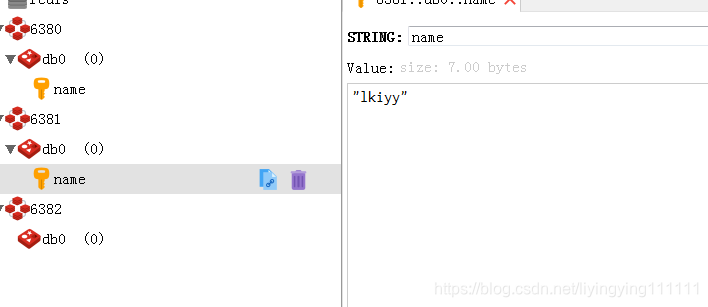前面实现了二级缓存。接下来要实现redis集群模式。本地实现6380 6381 6382模拟三台redis节点组成的集群
修改大致如下:
(1)修改redis单机节点的相关配置变为集群的配置;
spring.redis.cluster.nodes=127.0.0.1:6380,127.0.0.1:6381,127.0.0.1:6382
spring.redis.cluster.timeout=1000
spring.redis.cluster.max-redirects=3
spring.redis.cluster.password=123456
#单redis服务器加载此配置
spring.redis.database = 0
#spring.redis.host=127.0.0.1
#spring.redis.port=6379
#连接超时时间
#最大活跃连接数
spring.redis.jedis.pool.max-active=10
#最大空闲连接数
spring.redis.jedis.pool.max-idle=5
#最长等待时间。-1不等待
spring.redis.jedis.pool.max-wait=-1
#最小空闲数0
spring.redis.jedis.pool.min-idle=0
(2) redis集群的相关配置:有原先单机节点配置变为集群配置使用了jedispoolconconfig
package com.example.demo.config;
import com.example.demo.po.RedisClusterProperties;
import com.fasterxml.jackson.annotation.JsonAutoDetect;
import com.fasterxml.jackson.annotation.PropertyAccessor;
import com.fasterxml.jackson.databind.ObjectMapper;
import org.springframework.beans.factory.annotation.Autowired;
import org.springframework.beans.factory.annotation.Value;
import org.springframework.context.annotation.Bean;
import org.springframework.context.annotation.Configuration;
import org.springframework.context.annotation.PropertySource;
import org.springframework.core.env.MapPropertySource;
import org.springframework.data.redis.connection.RedisClusterConfiguration;
import org.springframework.data.redis.connection.RedisConnectionFactory;
import org.springframework.data.redis.connection.RedisNode;
import org.springframework.data.redis.connection.RedisPassword;
import org.springframework.data.redis.connection.jedis.JedisConnectionFactory;
import org.springframework.data.redis.connection.lettuce.LettuceConnectionFactory;
import org.springframework.data.redis.core.RedisTemplate;
import org.springframework.data.redis.serializer.Jackson2JsonRedisSerializer;
import org.springframework.data.redis.serializer.StringRedisSerializer;
import redis.clients.jedis.JedisPoolConfig;
import java.util.HashMap;
import java.util.HashSet;
import java.util.Map;
import java.util.Set;
@Configuration
public class RedisClusterConfig {
@Value("${spring.redis.jedis.pool.max-active}")
private String maxActive;
@Value("${spring.redis.jedis.pool.max-idle}")
private String maxIdle;
@Value("${spring.redis.jedis.pool.max-wait}")
private String maxWait;
@Value("${spring.redis.jedis.pool.min-idle}")
private String minIdle;
@Autowired
private RedisClusterProperties clusterProperties;
@Bean
public RedisTemplate<String,Object> redisTemplate(RedisConnectionFactory redisConnectionFactory){
RedisTemplate<String, Object> template = new RedisTemplate<String, Object>();
template.setConnectionFactory(redisConnectionFactory);
Jackson2JsonRedisSerializer jackson2JsonRedisSerializer = new Jackson2JsonRedisSerializer(Object.class);
ObjectMapper om = new ObjectMapper();
om.setVisibility(PropertyAccessor.ALL, JsonAutoDetect.Visibility.ANY);
om.enableDefaultTyping(ObjectMapper.DefaultTyping.NON_FINAL);
jackson2JsonRedisSerializer.setObjectMapper(om);
StringRedisSerializer stringRedisSerializer = new StringRedisSerializer();
// key采用String的序列化方式
template.setKeySerializer(stringRedisSerializer);
// hash的key也采用String的序列化方式
template.setHashKeySerializer(stringRedisSerializer);
// value序列化方式采用jackson
template.setValueSerializer(jackson2JsonRedisSerializer);
// hash的value序列化方式采用jackson
template.setHashValueSerializer(jackson2JsonRedisSerializer);
template.afterPropertiesSet();
return template;
}
/**
* redis集群配置
* @return
*/
@Bean
public RedisClusterConfiguration redisClusterConfiguration() {
RedisClusterConfiguration redisClusterConfiguration = new RedisClusterConfiguration();
//Set<RedisNode> clusterNodes
String[] serverArray = clusterProperties.getNodes().split(",");
Set<RedisNode> nodes = new HashSet<RedisNode>();
for(String ipPort:serverArray){
String[] ipAndPort = ipPort.split(":");
nodes.add(new RedisNode(ipAndPort[0].trim(),Integer.valueOf(ipAndPort[1])));
}
redisClusterConfiguration.setClusterNodes(nodes);
redisClusterConfiguration.setMaxRedirects(Integer.valueOf(clusterProperties.getMaxRedirects()));
redisClusterConfiguration.setPassword(RedisPassword.of(clusterProperties.getPassword()));
return redisClusterConfiguration;
}
/**
* @param
* @return
* @Description:redis连接工厂类
* @date 2018/10/25 19:45
*/
/* @Bean
public RedisConnectionFactory myLettuceConnectionFactory(RedisClusterConfiguration redisClusterConfiguration) {
RedisConnectionFactory redisConnectionFactory = new LettuceConnectionFactory(redisClusterConfiguration);
return redisConnectionFactory;
}*/
@Bean
public JedisPoolConfig getJedisPoolConfig() {
JedisPoolConfig jedisPoolConfig = new JedisPoolConfig();
// 最大空闲数
jedisPoolConfig.setMaxIdle(Integer.valueOf(maxIdle));
// 连接池的最大数据库连接数
jedisPoolConfig.setMaxTotal(Integer.valueOf(maxActive));
// 最大建立连接等待时间
jedisPoolConfig.setMaxWaitMillis(Integer.valueOf(maxWait));
return jedisPoolConfig;
}
/**
* @param
* @return
* @Description:redis连接工厂类
* @date 2018/10/25 19:45
*/
@Bean
public JedisConnectionFactory jedisConnectionFactory() {
//集群模式
JedisConnectionFactory factory = new JedisConnectionFactory(redisClusterConfiguration(),getJedisPoolConfig());
factory.setDatabase(0);
factory.setTimeout(clusterProperties.getTimeout());
factory.setUsePool(true);
return factory;
}
}
(3)集群启动后直接测试就行。被人亲测过。没有问题
在下图 两个节点中存储了name的信息






 本文详细介绍如何在本地搭建由三个节点组成的Redis集群,并通过Spring框架进行整合,实现集群模式下的二级缓存功能。文中提供了具体的配置代码示例,包括集群配置、连接池配置以及RedisTemplate的序列化设置。
本文详细介绍如何在本地搭建由三个节点组成的Redis集群,并通过Spring框架进行整合,实现集群模式下的二级缓存功能。文中提供了具体的配置代码示例,包括集群配置、连接池配置以及RedisTemplate的序列化设置。
















 21万+
21万+

 被折叠的 条评论
为什么被折叠?
被折叠的 条评论
为什么被折叠?








